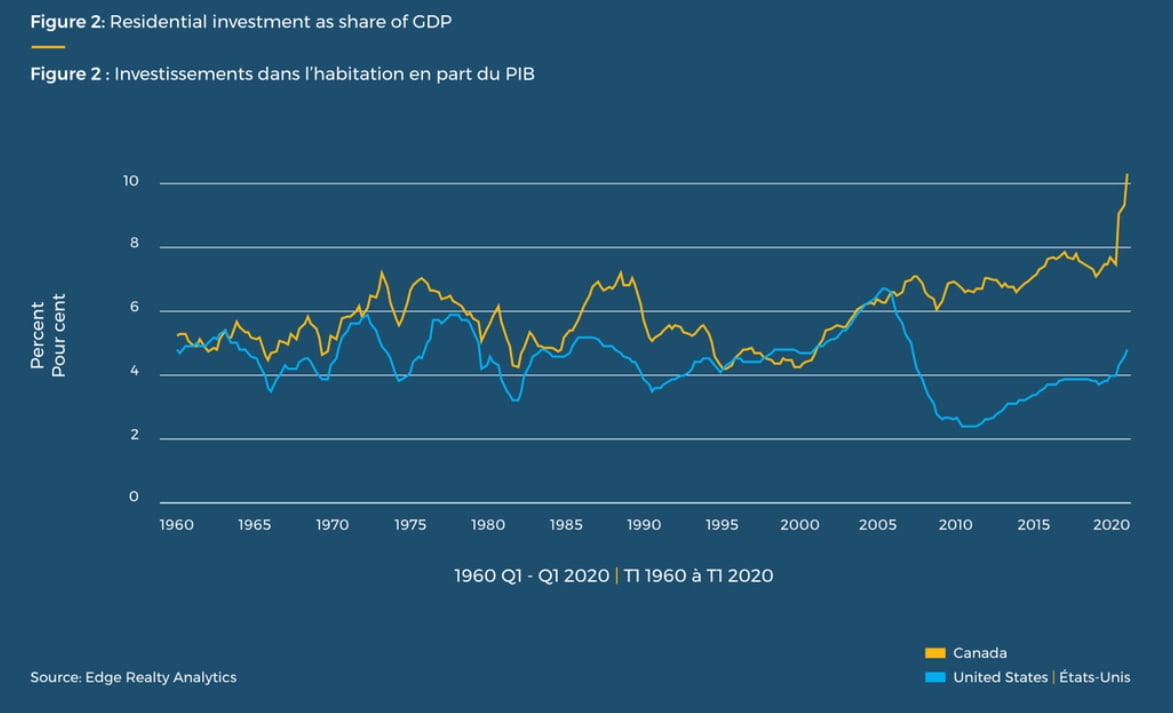The Sea Change in Canadian Mortgage Insurance
Few realize how dramatically Canada’s mortgage insurance market has changed. As any mortgage broker with a decade-plus of experience can tell you, borrowers are feeling this change in all too many ways.
Consider the numbers. As of the first quarter of 2021, “only 35% of outstanding residential mortgages extended by chartered banks were insured,” says CMHC. In 2012, this share was over 60%.
And insured mortgage balances just keep shrinking (down 5.3% year-over-year, according to OSFI data) while uninsured mortgage balances surge (+19%).
 Source: CMHC
Source: CMHC
What’s causing this growing gap?
It’s been a “long-standing trend,” CMHC says, fuelled by:
- Regulatory changes
- Making refinances and properties over $1 million uninsurable was a huge game-changer, as was introducing new stress tests.
- Soaring home prices
- Supply/demand imbalances drove home prices to the sky, pushing more homes over the $1 million insurability limit.
- Changes to portfolio insurance
- The portfolio insurance ‘Purpose Test’ in July 2016 played a big role, as did November 2016 regulations requiring low-ratio insured mortgages to meet the same criteria as high-ratio mortgages. Couple that with increases in insurance premium rates and this all “contributed significantly to the downward trend in portfolio insurance,” CMHC says.
Uninsured mortgage volumes have ballooned as a result, a trend that remains in full force today.
Meanwhile, both high-ratio insured (-6.7%) and conventional insured (-14.7%) dropped in the first half of 2021, versus the same period in 2020.
That might make you wonder how the risk profile is changing in Canada’s mortgage market. Well, CMHC has data on that. Using historical data on mortgage originations from OSFI’s E2 Mortgage Loans Report, it finds that:
- On average, the loan amounts are higher for uninsured mortgages than for insured mortgages
- That’s largely because uninsured mortgages have a “larger and increasing share of high-value residential mortgages of over $1 million,” CMHC notes. “The most noteworthy increase in newly originated mortgages was in the issuance of uninsured mortgages for purchases of property, which more than doubled the amount originated in the same quarter in 2020.”
- As of the second quarter of 2021, about 75% of insured mortgages were under $500,000, versus 57% for uninsured mortgages.
- Uninsured LTVs are climbing
- “Soaring property prices pushed the loan-to-value ratio distribution upwards for newly originated uninsured mortgages,” CMHC found.
- But this did not affect insured mortgages in the same way.” In fact, in 2020-21, chartered banks issued insured mortgages with higher equity stakes than in previous years.
- Among newly originated insured mortgages, 51.8% had an LTV from 90% up to and including 95%. This share is down from 55.4% in 2016, implying “higher equity stakes in newly originated insured mortgages,” CMHC says.
- Uninsured mortgages are increasingly being originated with higher total debt service (TDS) ratios
- A 44% TDS ratio is typically the maximum that most lenders will entertain for a prime mortgage borrower. Yet, among mortgages originated in the first half of 2021, almost one in four (23%) uninsured mortgages had a TDS ratio over 45%, compared to just 5% of insured mortgages.
- Meanwhile, the share of new uninsured mortgages with a TDS ratio of 40% or less has been “on a downtrend since the second half of 2020,” and CMHC says it decreased further in 2021.
What does it mean?
On the face of it, there’s unquestionably more risk in pockets of today’s uninsured mortgage market. Equity is an increasingly important safety net on higher-risk loans, and hence, some uninsured lenders will no doubt be put to the test as home equity shrinks in the next housing downturn.
Nobody can predict when that will happen, of course, but if inflation exacerbates our nation’s debt crisis, new supply finally offsets household formation and/or we end up with 150-200+ basis points of rate tightening, it’s not going to help.
Looking ahead, the insured/uninsured mix could change further, thanks to:
- A higher insurability limit
- The Liberals promised to increase the limit from $1 million to $1.25 million
- A stricter stress test
- OSFI and the Department of Finance review the minimum qualifying rate (currently 5.25%) next month. If they make the federal stress test tougher, more borrowers will shift to the uninsured market where—depending on the lender and mortgage type—it does not apply.
- First Time Home Buyer’s Incentive enhancements
- The Liberals floated FTHBI loans, which could drive more insured business.
- Lower default-insurance premiums
- Another Liberal idea that would incrementally fuel insurance demand (just what we need!).
- New funding methods
- New uninsured funding mechanisms, like residential mortgage-backed securities (RMBS) and private default insurance, could someday lower uninsured funding costs, reducing the insured-mortgage cost advantage.
- Other regulatory changes
- Things like higher capital requirements could shift the insured/uninsured balance “overnight.”
This shift from insured to uninsured mortgages argues for lower taxpayer risk, and that’s disputably been the case in terms of direct risk, notwithstanding all the lost government revenue from insurance operations.
But the sea change in Canada’s mortgage insurance regime begs countless questions. Are the policy benefits worth all the systemic costs? How big are the new latent risks that now lurk in our modern uninsured market? Have we simply shifted government-backed risks and increased costs on consumers, such that taxpayers are indirectly worse off? It’ll likely take a major housing downturn to reveal the answers.

